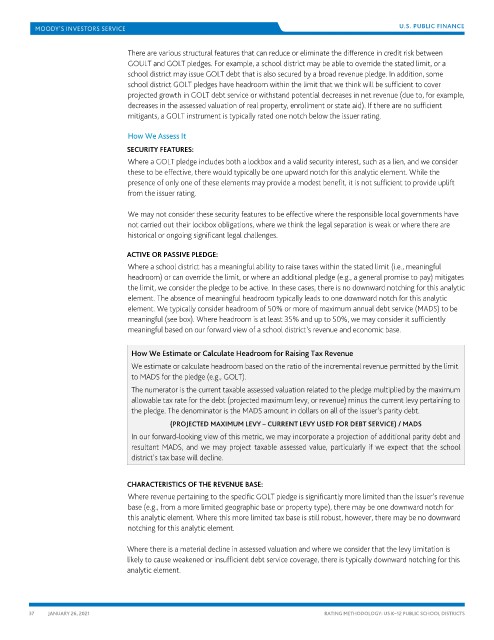Page 1676 - draft
P. 1676
U.S. PUBLIC FINANCE
There are various structural features that can reduce or eliminate the difference in credit risk between
GOULT and GOLT pledges. For example, a school district may be able to override the stated limit, or a
school district may issue GOLT debt that is also secured by a broad revenue pledge. In addition, some
school district GOLT pledges have headroom within the limit that we think will be sufficient to cover
projected growth in GOLT debt service or withstand potential decreases in net revenue (due to, for example,
decreases in the assessed valuation of real property, enrollment or state aid). If there are no sufficient
mitigants, a GOLT instrument is typically rated one notch below the issuer rating.
How We Assess It
SECURITY FEATURES:
Where a GOLT pledge includes both a lockbox and a valid security interest, such as a lien, and we consider
these to be effective, there would typically be one upward notch for this analytic element. While the
presence of only one of these elements may provide a modest benefit, it is not sufficient to provide uplift
from the issuer rating.
We may not consider these security features to be effective where the responsible local governments have
not carried out their lockbox obligations, where we think the legal separation is weak or where there are
historical or ongoing significant legal challenges.
ACTIVE OR PASSIVE PLEDGE:
Where a school district has a meaningful ability to raise taxes within the stated limit (i.e., meaningful
headroom) or can override the limit, or where an additional pledge (e.g., a general promise to pay) mitigates
the limit, we consider the pledge to be active. In these cases, there is no downward notching for this analytic
element. The absence of meaningful headroom typically leads to one downward notch for this analytic
element. We typically consider headroom of 50% or more of maximum annual debt service (MADS) to be
meaningful (see box). Where headroom is at least 35% and up to 50%, we may consider it sufficiently
meaningful based on our forward view of a school district’s revenue and economic base.
How We Estimate or Calculate Headroom for Raising Tax Revenue
We estimate or calculate headroom based on the ratio of the incremental revenue permitted by the limit
to MADS for the pledge (e.g., GOLT).
The numerator is the current taxable assessed valuation related to the pledge multiplied by the maximum
allowable tax rate for the debt (projected maximum levy, or revenue) minus the current levy pertaining to
the pledge. The denominator is the MADS amount in dollars on all of the issuer’s parity debt.
(PROJECTED MAXIMUM LEVY – CURRENT LEVY USED FOR DEBT SERVICE) / MADS
In our forward-looking view of this metric, we may incorporate a projection of additional parity debt and
resultant MADS, and we may project taxable assessed value, particularly if we expect that the school
district’s tax base will decline.
CHARACTERISTICS OF THE REVENUE BASE:
Where revenue pertaining to the specific GOLT pledge is significantly more limited than the issuer’s revenue
base (e.g., from a more limited geographic base or property type), there may be one downward notch for
this analytic element. Where this more limited tax base is still robust, however, there may be no downward
notching for this analytic element.
Where there is a material decline in assessed valuation and where we consider that the levy limitation is
likely to cause weakened or insufficient debt service coverage, there is typically downward notching for this
analytic element.
37 JANUARY 26, 2021 RATING METHODOLOGY: US K–12 PUBLIC SCHOOL DISTRICTS

